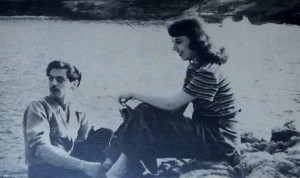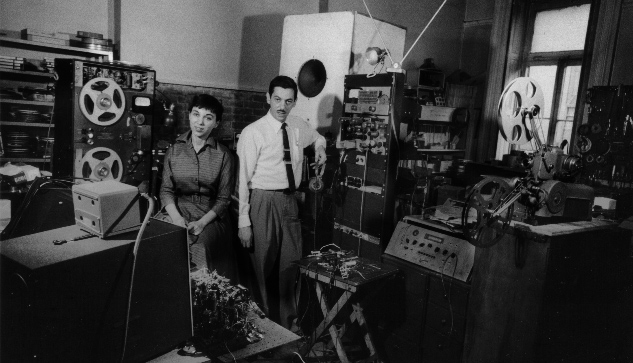In 1946, Louis Barron, age 26, returned to Minneapolis from the tropical paradise of Chiapas, Mexico, where he’d lived in a small village, subsisting on rice and beans, self-reflecting, and trying to write a play . . . he met Charlotte Wind, age 21, of Fargo, and found a kindred spirit. . . the two shared creative interests, musical backgrounds, and desires to make names for themselves . . .
. . . at their wedding, the couple received a large, early tape recorder . . . moving to Monterey, California, reading her work at a San Francisco book store, and asked to record her . . . they recorded Anaïs in a ten-day-long taping marathon and meticulously edited, hand-splicing the many segments of tape together, creating two audiobook records . . . the three became close friends . . . Anaïs nicknamed Charlotte “Bébé”, which became Bebe . . .
. . . in 1949, Anaïs returned to husband Hugh Guiler (banker, filmmaker, engraver) aka Ian Hugo, in Greenwich Village, a creative center of Manhattan . . . the Barrons quickly followed her there . . . there they became immersed among a bohemian society called the “Artist’s Club,” a group sharing creative ideas over lunch and parties . . . the Barrons grew intellectually and socially, during this exciting time . . .
. . . in 1950, the Barrons ended their audiobooks venture, and began work in electronic or cybernetic music, manipulating vacuum tube circuits to create an extensive catalog of sounds . . . they collaborated with experimental musicians John Cage and David Tudor to create Williams Mix . . . they provided sound effects for Hugh Guiler and Anaïs Nin’s avant garde films Bells of Atlantis and Jazz of Lights, and for several plays and commercials.
. . . in 1955, the Barrons got their big break, creating both sound effects and music for the high-budget MGM Science Fiction movie, Forbidden Planet . . . their all-electronic soundtrack became legendary. . . though the musicians’ union required it to be credited it as “electronic tonalities” in the movie’s credits . . . on the coattails of this success, the Barrons scored the popular 1957 Broadway play by Gore Vidal, Visit to a Small Planet.
. . . in 1961 the Barrons moved to Los Angeles to be closer to Hollywood . . . however, they did not have a major film project after Forbidden Planet, and they divorced in 1969 . . . in 1976, they cooperated on the production and release of the movie’s original soundtrack, first on vinyl then on CD . . . Louis died in 1989 and Bebe in 2008, but their pioneering electronic music and recording work live on . . .
© 2012, Barron Sound Portraits




